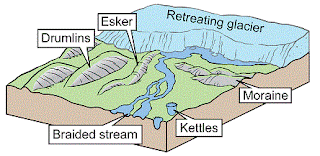 |
| Continental glacial features |
Taylor was attempting to rewrite a fairly accurate, although rather sparse, version of the same "information" about glaciation submitted years ago by Vee Enne (also known as Victoria Nicks). We estimate that perhaps 80% of what Lindsey pounded out was more or less accurate at the middle-school level; but while an excellent free-throw average, 80% just doesn't cut it in science. We thought perhaps it would be a good idea to correct some of Taylor's misstatements and misconceptions. So here goes:
- "Alpine glaciers create valleys by pushing soil and rocks out of their way as they grow." – No, alpine glaciers expand existing stream valleys by removing rock from the walls and floor of the valley.
- "Ice sheets do not create landscape features as they spread. They are so large and powerful that the land beneath them is typically smoothed out." – That's odd, because somewhere above that claim, Taylor listed "drumlins" as a glacial landform; drumlins are created by continental glaciation. The big ice sheets also create eskers, moraines, kames, and kettles; as well as glacial lakes. You'd think Lindsey would know that from her studies at U. of Wisconsin in the middle of a glacial landscape.
- "As the glacier moves downhill, it plucks rocks from the ground and they become frozen in the glacier..." – Plucking occurs at the head of an alpine glacier in the cirque, and involves the shattering of solid rock as water freezes in cracks. It's not as "the glacier moves downhill..."
- "Drumlins are hills of deposited moraine." – No, Lindsey, glaciers are composed of till, not "moraine."
- "As they grow, the [sic] push forward down mountainsides... Rocks that are carried by glaciers, sometimes hundreds of miles, are called glacial erratics." – While "erratic" implies travel from somewhere "up-ice," the erratics moved by glaciers that move "down mountainsides" – alpine glaciers – move just a few miles, not "hundreds of miles."
Apropos one of Taylor's offhand comments; when it comes to landforms created by continental glaciation, Lindsey missed the boat big-time: perhaps the most prominent glacial landforms of North America are the Great Lakes. Try writing those off as "smoothed out"!
So much of what Lindsey had to say (and what Sylvie signed off on) is pure bushwa that we would be greatly remiss if we did not name Taylor today's Dumbass of the Day for this half-assed version of glaciology.
¹ Supposedly Abraham Lincoln, but that's not certain.
SI - GLACIERS
No comments:
Post a Comment